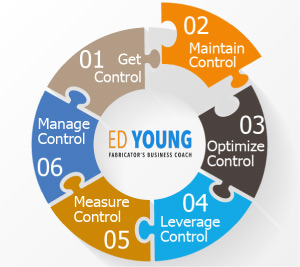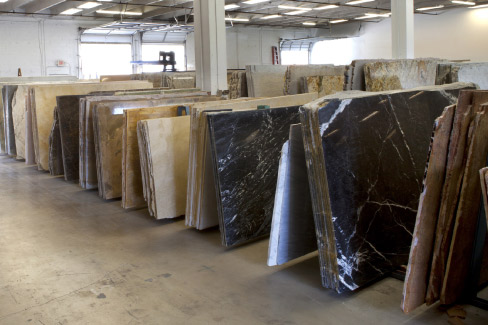Increase Inventory to Increase Profit
This is the second in our series of six articles which will show you how to get predictability and control of your countertop shop. Additionally, you can increase capacity utilization by 30 percent or more and shorten your lead time.
Ed Young
Fabricator’s Business Coach
Short lead times are a tremendous competitive advantage.
 |
|
This is the second in our series of six articles which will show you how to get predictability and control of your countertop shop. Additionally, you can increase capacity utilization by 30 percent or more and shorten your lead time. |
The fewer jobs in your shop (work in process – WIP), the shorter your lead time. Having a lot of jobs in your shop means your lead times may be longer than you like. Lean is a popular process improvement tool and it pushes for the lowest inventory to generate the shortest lead times possible – and, therefore, great competitive advantage. So, if we want short lead times, then this must be the best business solution, right?
Wrong! The lower your WIP levels, the more you are impacted by variation in process performance. Variation comes from:
- Inconsistent machine perfor- mance due to wear and tear
- Different process times due to different materials
- Tool wear
- Inconsistent human performance
- Absenteeism
All production operations have inherent variation and, while it can be managed to some degree, this variation cannot be eliminated. Worse still, that variation accumulates through the steps of your fabrication process rather than averaging out. The result is a whip effect that makes it difficult to predict customer install dates. Since this variation can’t be eliminated, lowering WIP too much can hurt your ability to hit your promised install dates and hurt your ability to delight your customer.
Since we can’t completely stop the variation, how do we keep output of the plant consistent so we can meet our promised install dates and still make a profit – all while having short lead times?
Last month we talked about how bottlenecks constantly moving around a plant creates chaos. We talked about the need to decide where your constraint should be and how you can use various tools to help drive the bottleneck to the constraint.
Once you have accomplished that, you will need to protect the constraint from the variation accumulating throughout the processes that feed it. This is critical since, by definition, the constraint controls the throughput of the entire plant. It defines the capacity of the entire facility to make money. If the constraint stops running for an hour, that is an hour of capacity lost for the entire facility. That means you lose an hour of capacity to make money!
Having extra inventory in front of the constraint helps ensure it doesn’t stop due to lack of work. It gives you time to ‘catch up’ if a machine in the production flow feeding the constraint breaks down, or if a slab doesn’t show up on time, of if a really complex job slows everything down. It also gives you time to inspect those jobs to make sure you don’t waste constraint time processing a part that is already defective.
 |
|
The right amount of inventory in the right place protects the throughput of your shop. |
Since this inventory buffers the constraint from everything that happens prior to it, let’s call it a buffer.
How large should the buffer be? You can conduct an extensive statistical analysis, or you can make a rough guesstimate and adjust as needed. In most operations, about a day of buffer stock is a good place to start.
- Monitor the buffer levels over time (track the data!).
- Record the issues that cause the buffer level to increase and the ones that cause it to decrease.
- Once you have a good feel for how prior processes im- pact the supply of jobs to the constraint, start lowering inventory between those prior processes.
- As those WIP levels begin to stabilize, start lowering the size of the buffer.
- You will probably end up stabilizing the buffer at somewhere around a half- day of inventory.
Some folks won’t be comfortable with this S.W.A.G. approach but, in the long run, it will save a lot of time and arguments. The reason is, if you conduct a statistical analysis, people will argue about the assumptions you used or the calculations in the analysis. It always happens and you can easily end up with Analysis Paralysis and get nothing done. If you do happen to get your analysis approved, it will be implemented, you will monitor performance of the buffer, and then you will adjust it accordingly. My recommendation just saves you the analysis and the subsequent arguing – and gets you results quicker.
So far in this series, we’ve talked about constraints, and buffers. There are a few additional tools needed to make this system work smoothly for you. One of them is knowing how to maximize your capacity to make money. Look for that in our next article. Here’s an excerpt:
You are paying for all the capacity in your shop. How well are you using it?
The maximum amount of money your shop can generate in a day is equal to the quantity of value-added hours you execute in that day. If you want to make more money without hiring more people or buying new equipment, then you need to find ways to reduce the non-value-added activities in your shop.
To find out more about how to Increase Inventory to Increase Profit as well as how to Reduce the Chaos, Make More Money, and Get Your Life Back – email the author – Ed@FabricatorsCoach.com.
In addition to having run a countertop fabrication shop, Ed has also helped many fab shop owners become very successful.
He is a seasoned manufacturing manager and coach who has helped hundreds of companies from single person startups to large international corporations. As a former business owner, he understands the responsibility to make payroll while also satisfying customers. Ed can be reached at Ed@FabricatorsCoach.com.